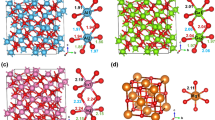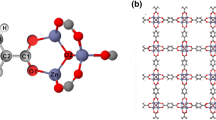Abstract
Al17 clusters exhibit apparent changes in curvature, which resemble macroscopic metal tips. Here, we show, using the density functional theory method, how surface charges of Al17q (q = −2 to +3) ions affect the adsorption and dissociation behavior of HCl molecules. Geometries, adsorption energies, vibrational frequencies, Mulliken population analysis and transition states of (Al17HCl)q (q = −2 to +3) adsorption complexes were studied. The results revealed that HCl molecules tend to locate on tip sites of the Al17q (q = −2 to +3) ions. Anionic adsorption complexes are prone to H affinity adsorption, whereas cationic adsorption complexes favor Cl-affinity adsorptions. These adsorption behaviors look quite like macroscopic tip effects. H–Cl bonds of the adsorption complexes weaken with an increase in either positive or negative charge. Dissociation barriers of the H–Cl bonds exhibit binding energies that are 2 orders of magnitude smaller than those of an isolated HCl molecule. Considering adsorption energies and dissociation barriers comprehensively, HCl molecules should dissociate spontaneously for all the models considered. Generally, the more negative charges the clusters carry, the more energy the reaction will release.

Dissociation barriers of the H–Cl bonds in Al17q (q = −2 − +3) cluster ions exhibit energy barriers ~2 orders of magnitude smaller than isolated HCI molecules




Similar content being viewed by others
Change history
03 December 2019
The original version of this article unfortunately contained a mistake. “Southwest Minzu Nationalities” in affiliation 1 should be “Southwest Minzu University”.
References
Roach PJ, Woodward WH, Castleman AW et al (2009) Complementary active sites cause size-selective reactivity of aluminum cluster anions with water. Science 323:492–495. https://doi.org/10.1126/science.1165884
Yuan QH, Li J, Liu ZF (2011) Dynamic factors in the reactions between the magic cluster Al13 − and HCl/HI. Phys Chem Chem Phys 13:9871–9879. https://doi.org/10.1039/C0CP02187C
Reber AC, Roach PJ, Woodward WH et al (2012) Edge-induced active sites enhance the reactivity of large aluminum cluster anions with alcohols. J Phys Chem A 116:8085–8091. https://doi.org/10.1021/jp3047196
Álvarez-Barcia S, Flores JR (2012) Size, adsorption site, and spin effects in the reaction of Al clusters with water molecules: Al17 and Al28 as examples. J Phys Chem A 116:8040–8050. https://doi.org/10.1021/jp303911s
Alexandrou EI, Gross A, Bacalis NC (2010) Theoretical investigation of the interaction of CH4 with Al2 and Al3 neutral and charged clusters. J Chem Phys 132:154701. https://doi.org/10.1063/1.3376174
Wang L, Kuklja MM (2010) First-principles study of small aluminum clusters: oxygen adsorptions, oxidation and phase stability. J Phys Chem Solids 71:140–144. https://doi.org/10.1016/j.jpcs.2009.07.021
Xiang H, Kang J, Wei SH et al (2009) Shape control of Al nanoclusters by ligand size. J Am Chem Soc 131:8522–8526. https://doi.org/10.1021/ja900965w
Shimojo F, Ohmura S, Kalia RK et al (2010) Molecular dynamics simulations of rapid hydrogen production from water using aluminum clusters as catalyzers. Phys Rev Lett 104:126102. https://doi.org/10.1103/PhysRevLett.104.126102
Liu T, Fu B, Zhang DH (2017) HCl dissociating on a rigid Au ( 111 ) surface : a six-dimensional quantum mechanical study on a new potential energy surface based on the RPBE functional HCl dissociating on a rigid Au ( 111 ) surface : a six-dimensional quantum mechanical study on a new. J Chem Phys 146:164706. https://doi.org/10.1063/1.4982051
Geweke J, Shirhatti PR, Rahinov I et al (2016) Vibrational energy transfer near a dissociative adsorption transition state: state-to-state study of HCl collisions at Au(111). J Chem Phys 145:054709. https://doi.org/10.1063/1.4959968
Grotemeyer M, Pehlke E (2014) Electronic energy dissipation during scattering of Vibrationally excited molecules at metal surfaces: ab initio simulations for HCl/Al ( 111 ). Phys Rev Lett 112:043201. https://doi.org/10.1103/PhysRevLett.112.043201
Kim JC, Kim KH, Jung J, Han YK (2008) Reaction mechanisms of dissociative chemisorption of HI, I2, and CH3I on a magic cluster Al13 −. J Comput Chem 29:1626–1631 http://doi.wiley.com/10.1002/jcc.20921
Burgert R, Schnöckel H, Olzmann M, Bowen KH (2006) The chlorination of the [Al13]− cluster and the stepwise formation of its intermediate products, [Al11]−, [Al9]−, and [Al7]−: a model reaction for the oxidation of metals? Angew Chem Int Ed 45:1476–1479. https://doi.org/10.1002/anie.200502957
Bergeron DE, Castleman AW, Morisato T, Khanna SN (2004) Formation and properties of halogenated aluminum clusters. J Chem Phys 121:10456–10466. https://doi.org/10.1063/1.1806416
Burgert R, Stokes ST, Bowen KH, Schnöckel H (2006) Primary reaction steps of Al13 − clusters in an HCl atmosphere: snapshots of the dissolution of a base metal. J Am Chem Soc 128:7904–7908. https://doi.org/10.1021/ja060613x
Manil B, Maunoury L, Huber BA et al (2003) Highly charged clusters of fullerenes: charge mobility and appearance sizes. Phys Rev Lett 91:1–4. https://doi.org/10.1103/PhysRevLett.91.215504
Singh R, Tripathi VK, Vatsa RK, Das D (2017) Nanosecond laser-cluster interactions at 109−1012 W/cm2. Phys Plasmas 24:082111. https://doi.org/10.1063/1.4997452
Niu D, Li H, Liang F et al (2005) Controllable generation of highly stripped ions with different charges by nanosecond laser ionization of clusters at different wavelengths. Appl Phys Lett 87:2003–2006. https://doi.org/10.1063/1.1997281
Fennel T, Meiwes-Broer KH, Tiggesbäumker J et al (2010) Laser-driven nonlinear cluster dynamics. Rev Mod Phys 82:1793–1842. https://doi.org/10.1103/RevModPhys.82.1793
Köller L, Schumacher M, Köhn J et al (1999) Plasmon-enhanced multi-ionization of small metal clusters in strong femtosecond laser fields. Phys Rev Lett 82:3783–3786. https://doi.org/10.1103/PhysRevLett.82.3783
Lebeault MA, Viallon J, Chevaleyre J et al (2002) Resonant coupling of small size-controlled lead clusters with an intense laser field. Eur Phys J D 20:233–242. https://doi.org/10.1140/epjd/e2002-00115-2
Radcliffe P, Döppner T, Schumacher M et al (2005) Generation of highly charged and energetic ions from the interaction of strong laser pulses with coinage metal clusters. Contrib Plasm Phys 45:424–431. https://doi.org/10.1002/ctpp.200510048
Schumacher M, Teuber S, Köller L et al (1999) Clusters in strong laser fields: comparison between carbon, platinum, and lead clusters. Eur Phys J D 9:411–414. https://doi.org/10.1007/s100530050468
Su MG, Cao SQ, Sun DX et al (2016) Investigation of temporal-resolved emission spectra of highly charged Al ions from laser-produced plasmas. Phys Plasmas 23:033302. https://doi.org/10.1063/1.4944504
Launoy T, Béroff K, Chabot M et al (2017) Ion-pair dissociation of highly excited carbon clusters: size and charge effects. Phys Rev A 95:1–12. https://doi.org/10.1103/PhysRevA.95.022711
Deaven DM, Ho KM (1995) Molecular geometry optimization with a genetic algorithm. Phys Rev Lett 75:288–291. https://doi.org/10.1103/PhysRevLett.75.288
Liu Y, Hua Y, Jiang M et al (2012) Theoretical study of the geometries and dissociation energies of molecular water on neutral aluminum clusters Aln (n=2–25). J Chem Phys 136:084703. https://doi.org/10.1063/1.3685603
Delley B (2000) From molecules to solids with the DMol3 approach. J Chem Phys 113:7756. https://doi.org/10.1063/1.1316015
Delley B (1990) An all-electron numerical method for solving the local density functional for polyatomic molecules. J Chem Phys 92:508. https://doi.org/10.1063/1.458452
Delley B (1991) Analytic energy derivatives in the numerical local-density-functional approach. J Chem Phys 94:7245. https://doi.org/10.1063/1.460208
Becke AD (1988) A multicenter numerical integration scheme for polyatomic molecules. J Chem Phys 88:2547. https://doi.org/10.1063/1.454033
Perdew JP, Wang Y (1992) Accurate and simple analytic representation of the electron-gas correlation energy. Phys Rev B 45:13244–13249. https://doi.org/10.1103/PhysRevB.45.13244
Pfrommer BG, Côté M, Louie SG, Cohen ML (1997) Relaxation of crystals with the quasi-Newton method. J Comput Phys 131:233–240. https://doi.org/10.1006/jcph.1996.5612
Yu Z, Zhang X, Huo P, Gao K (2017) Stability and electronic properties of WnX(n=1-7, X= cu, Mo) clusters. Eur Phys J Plus 132:451. https://doi.org/10.1140/epjp/i2017-11719-x
Zhang C, Hu SX, Liu HT et al (2018) Bonding properties and oxidation states of plutonium in Pu2O2 (n=1-8) molecules studied by using screened hybrid density functional theory. J Phys Chem A 122:4085–4091. https://doi.org/10.1021/acs.jpca.7b12324
Pino I, Kroes GJ, van Hemert MC (2010) Hydrogen dissociation on small aluminum clusters. J Chem Phys 133:184304. https://doi.org/10.1063/1.3502493
Herzberg G (1950) Molecular spectra and molecular structure I - spectra of diatomic molecules, 2nd edn. Van Nostrand Reinhold, New York
Huber KP, Herzberg G (1979) Molecular spectra and molecular structure: IV. Constants of diatomic molecules, 1st edn. Van Nostrand Reinhold, New York
Lide DR (2003) Handbook of chemistry and physics on CD-ROM. CRC, Boca Raton
Cai MF, Dzugan TP, Bondybey VE (1989) Fluorescence studies of LASER vaporized aluminum dimer: evidence for a ground state of aluminum dimer. Chem Phys Lett 155:430–436. https://doi.org/10.1016/0009-2614(89)87181-7
Halgren TA, Lipscohlb WN (1977) The synchronous-transit method for determining reaction pathways and locating molecular transition states. Chem Phys Lett 49:225–232. https://doi.org/10.1016/0009-2614(77)80574-5
Acknowledgments
We are grateful to the reviewers for their valuable suggestions on improving our paper. The authors acknowledge grant from the Fundamental Research Fund for the Central Universities, Southwest University for Nationalities, China under Grant number 2017NZYQN44.
Author information
Authors and Affiliations
Corresponding author
Additional information
Publisher’s note
Springer Nature remains neutral with regard to jurisdictional claims in published maps and institutional affiliations.
Rights and permissions
About this article
Cite this article
Liu, Y., Hua, Y., Yan, A. et al. Adsorption and dissociation of gas-phase HCl molecules on Al17q (q = −2 − +3) ions. J Mol Model 25, 214 (2019). https://doi.org/10.1007/s00894-019-4099-z
Received:
Accepted:
Published:
DOI: https://doi.org/10.1007/s00894-019-4099-z




